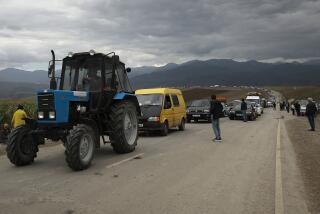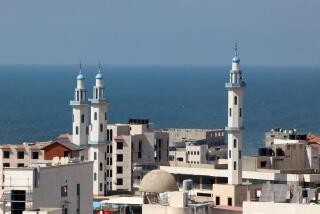A High-Speed Quest From Desert Kingdom to Russian Steppe
“The Siege of Isfahan” is a breezy tale set in 18th century Persia, heavy on plot, light on introspection--but leave it to a French novelist to include a philosophical epilogue about his yarn. “A historical novel reconstructs the hills of History,” Jean-Christophe Rufin writes in a brief postscript, “it restages what actually happened. An adventure novel takes place more in History’s valleys. It fills in the unknown and provides a reality . . . where we have no knowledge at all. It is to this second category that ‘The Abyssinian’ and ‘The Siege of Isfahan’ belong.” Well, there you have it.
“The Abyssinian,” the prequel to the present novel, introduced us to Jean-Baptiste Poncet, a French apothecary sent to the Sudan by the king of France on a secret mission. Though Poncet and many of the same characters reappear in “The Siege of Isfahan,” this new novel requires no prior knowledge of the earlier book. It stands on its own as an adventure story of the first order--intelligently written, with a labyrinthine plot, exotic locations, plus the inestimable virtue of never taking itself too seriously.
In the best tradition of Cervantes or Fielding, Rufin’s prose gallops along and transports us from one exotic location to another. The story cascades from one crisis to the next and jumps from character to character every five to 10 pages.
There are at least 10 significant characters, though the central protagonist is clearly Poncet. When the present novel begins, he is living in marital bliss in early 18th century Isfahan (which was the capital of the Safavid empire that ruled Persia from the 16th through 18th centuries). Poncet and his wife, Alix, whom he abducted from her father the French consul in Cairo some 20 years earlier, are visited by an old friend who informs them that the lumbering Swede Juremi, once Poncet’s close friend and partner, has been captured by Russian troops during a battle. That propels Poncet to go off into the Russian steppe in search of his friend. But in order to escape from the Persian shah, who has unexpectedly demanded Poncet’s services as an herbalist, Poncet concocts an elaborate lie and stages his own death. The rest of the novel tracks the ripple effects of that lie, as well as the rapid collapse of the Persian empire at the hands of the invading Afghans, who lay siege to Isfahan and eventually capture the city.
In the process, all the loose ends are tied up, and though that may be giving away some of the suspense, the pleasure of “The Siege of Isfahan” is not in the outcome but in the journey. Poncet makes his way from Isfahan through eastern Turkey into the Caucasus, where he has a brief encounter with Tsar Peter the Great, to the north of the Caspian Sea, through what is now Kazakhstan, into Afghanistan, and finally back to Persia and Isfahan. Meanwhile, his wife and friends have had their own adventures with the shah and the Afghan conquerors.
Though Poncet proves a skilled liar, his passion is reserved not for deceit but for his dear friend Juremi and his wife Alix. He ultimately prefers the epithet of faithful husband to that of clever rogue. Describing the consequences of Poncet’s odyssey, Rufin writes, “Another man had returned, his spirit rounded like a pebble washed in every storm, saturated with hardships, drunk with the beauty of the world, and filled with a love that now owned nothing to circumstances and everything to dreams and to freedom.”
It’s hard to judge prose in translation, but Rufin clearly has a speculative bent, and this rather conventional adventure story is leavened by moments of reflection and poetry. Rufin has a deft touch. He doesn’t go on about it, and that makes those poetic moments effective rather than tedious. That applies to description as well. “Afghanistan,” he writes, “is a desert in a rage. Gray and unvarying with its scaly surface of pebbles, it has the harshness, the denudation, and the aridity of the desert. But instead of lying flat like the steppe, or rolling gently, the Afghan desert rears up and coils on itself violently.” This is wonderful stuff, and used discretely, it adds layers of emotion and texture to the narrative.
Rufin’s frenetic pacing and the detailed descriptions of locale leave little room for deep character development. His characters aren’t caricatures, but neither are they psychologically deep. Blessed with skill and intelligence, Rufin has given us a breezy tale of unusual depth that is easy to enjoy, delightful to get lost in and quietly, unequivocally respectful of our desire to read a book that is at once fun and poignant.
More to Read
Sign up for our Book Club newsletter
Get the latest news, events and more from the Los Angeles Times Book Club, and help us get L.A. reading and talking.
You may occasionally receive promotional content from the Los Angeles Times.






